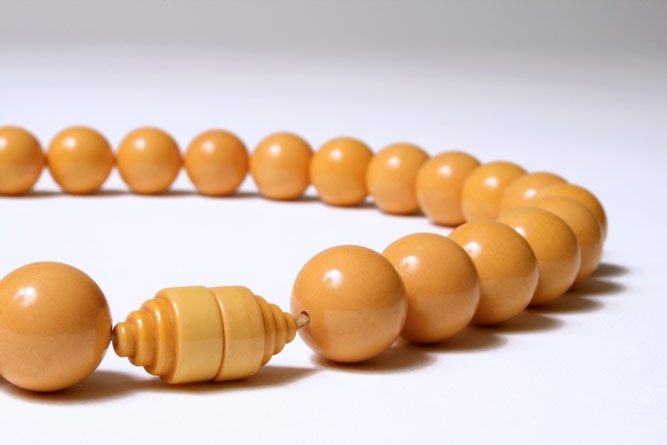Identifying Bakelite

Estate sales frequently have large collections of costume jewelry. From faux-pearls and colorful brooches to stackable bracelets, the inexpensive baubles have an undeniable charm. And while some individual pieces may have more value than others, there is one particular type of costume jewelry that has become a collector’s item, and often comes with a collector’s item price tag.
At first glance, Bakelite jewelry may look like your average plastic trinket. But it’s made of one of the earliest plastic resins, and its bright, saturated colors and retro feel have helped it continue its popularity on the vintage market.

Bakelite (pronounced with three syllables, by the way: the middle E is short, not silent) was created by Belgian-American chemist Leo Baekeland in 1907 with industrial uses in mind. It’s nonconductive and heat-resistant, making it ideal for use in electrical insulators and radio and telephone casings. Unlike other plastics, Bakelite cannot be melted down and reused—heat will not change its shape.
But the material was quickly adopted for a variety of purposes: game pieces (dominoes, dice, etc.), electric guitars, gun magazines, flatware handles, napkin rings, and, of course, fashion.
Fun fact: Baekeland’s contraption for mass-producing Bakelite was called the Bakelizer. If that doesn’t make you want to invent something just to name it after yourself, I don’t know what will.
Costume jewelry makers jumped onto the Bakelite bandwagon by the 1930s, recognizing its ability to be polished, colored, marbled, carved, and even laminated together to create multicolored pieces. Designers like Coco Chanel started incorporating Baekeland’s product into their work. and the jewelry and accessories were gracing fashion magazines.

Most of the early 19th century uses for Bakelite have fallen by the wayside, the demand for the vintage jewelry continues.
It’s important to know different ways to identify Bakelite jewelry, so you don’t find yourself unintentionally purchasing lucite or more common plastic pieces. While that jewelry has its own charms, when you’re looking for Bakelite and paying for Bakelite, you want to be certain.

Some of the testing methods may need to be reserved for home, away from the questioning eyes of the seller, but others can be employed while you shop.
Tips for Identifying Bakelite
The basic rule of thumb is: keep your senses about you.
Look
First, check for seams. Unlike other plastic jewelry, Bakelite is not poured into molds. Instead, pieces are formed from raw material—the pieces would then be cut, shaped, and polished, which means there will be no visible seam anywhere on the piece.
At home you can use a cotton swap and simichrome polish, a popular metal polish, to check for authenticity. With a clean cloth, rub a small amount of polish onto the jewelry, in an inconspicuous place. If the part of the cloth that touched the jewelry turns yellow, you’ve got Bakelite. Any other color, and you likely do not.
But remember, Simichrome can alter the color of Bakelite if not cleaned up properly, so be sure to test in an inconspicuous area, and wipe the tested area thoroughly with a clean cloth when the test is completed.
It should also be noted that Bakelite’s colors will change over time. A clear bracelet, for example, made over a half century ago, may now take on a brown hue.
Smell
Bakelite is a resin made of a phenol formaldehyde compound. If you put it to your nose, you won’t smell anything. (If this were not the case, I can’t imagine it lasting long on the market originally.) But heat the bauble up, and an acrid smell will come through, not unlike paint thinner. While you may not reasonably be able to walk through an estate sale with a cup of hot water, dipping the jewelry into hot water for a few seconds is a good way to quickly release the scent, if one exists, and discern whether a piece is Bakelite or not.
A tactic less likely to be frowned upon by vendors would be to rub your finger against the plastic. The friction should heat it up enough to release the phenol smell.
Listen
The sound of two pieces of Bakelite tapped together is decidedly different—clunkier—than other plastics. It might take some time to recognize the difference, if you don’t have pieces to compare. But it’s a good, quick test when you’re in a heat-of-the-moment decision.
Touch
Be sure to consider heft when you’re discerning the material. Bakelite is heavier than other plastics. Hold a piece of Bakelite in one hand, and another plastic bauble of a similar size in the other, and there will be a considerable difference.
Taste
Just kidding, guys. Don’t lick the Bakelite.
Seriously. Don’t do it.
Some jewelry designers continue to create new pieces from old Bakelite, so it’s important to keep your eyes open for that, too, if vintage is what you’re after. Older Bakelite jewelry will show signs of discoloration. Bracelets, for example, will not be the same color on the inside and the outside due to wear. Hardware will more likely be glued into place in newer pieces.
The value of Bakelite jewelry varies between pieces as well as markets. Carved, laminated, and multi-colored jewelry tends to command higher prices than solid pieces, but there’s a collector for every type of vintage Bakelite you might find. So keep your eyes, ears, and nose open, and you might just find the piece you’re looking for.
And remember: don’t lick the Bakelite.